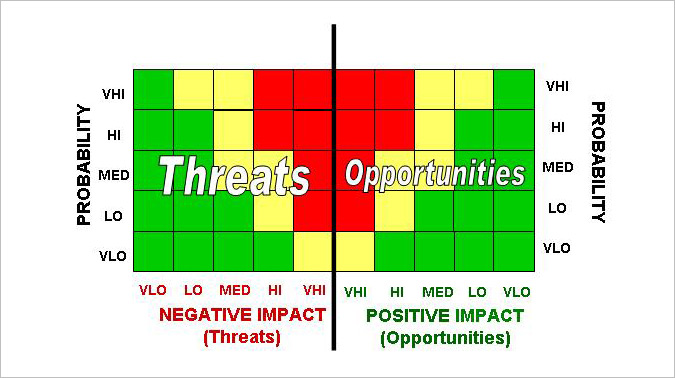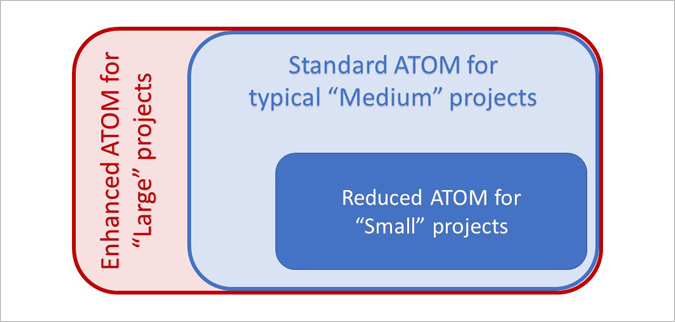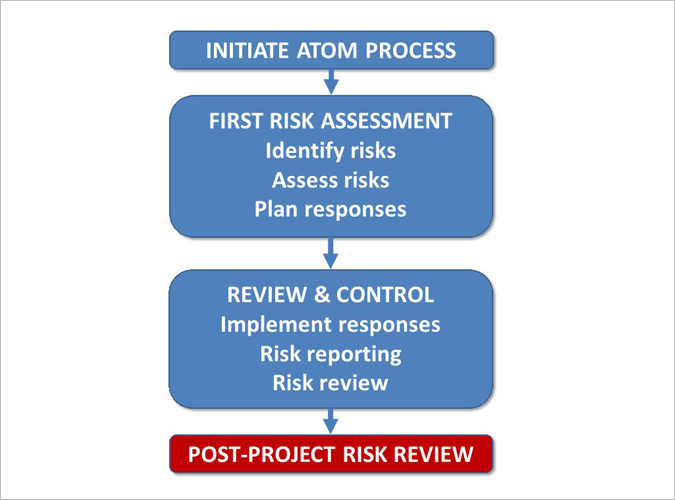The ATOM Methodology has been developed by two globally-recognised experts, based on their decades of successfully managing risk on projects and advising others on how to do so. The approach is applicable to any project in any industry, and has a number of unique features. Click on the links below to discover what makes the ATOM Methodology different from the rest.
 ATOM stands for Active Threat & Opportunity Management. This tells you that the methodology applies equally to both threats and opportunities. Many other approaches only deal with threats, but ATOM specifically targets both upside and downside risks, helping you maximise opportunities and minimise threats in a single process.
ATOM stands for Active Threat & Opportunity Management. This tells you that the methodology applies equally to both threats and opportunities. Many other approaches only deal with threats, but ATOM specifically targets both upside and downside risks, helping you maximise opportunities and minimise threats in a single process.
Other risk management processes also only address individual project risks, and ATOM does this too. But it also helps you to answer the question “How risky is my project?”, by identifying, quantifying and managing overall project risk.
 Each project is unique, although they are all risky. But project risk management is not one-size-fits-all. Smaller projects can take advantage of a cut-down risk process, while larger ones need a more rigorous approach. Unlike other risk methods, ATOM starts with a project scaling step, categorising each project as Large, Medium or Small. The ATOM Methodology then has three variants, allowing you to tailor the risk approach to the specific needs of your project.
Each project is unique, although they are all risky. But project risk management is not one-size-fits-all. Smaller projects can take advantage of a cut-down risk process, while larger ones need a more rigorous approach. Unlike other risk methods, ATOM starts with a project scaling step, categorising each project as Large, Medium or Small. The ATOM Methodology then has three variants, allowing you to tailor the risk approach to the specific needs of your project.
 When a project is initiated, the project team has their first chance to consider threats and opportunities on their project. They need to pay special attention and apply extra effort for this initial look at risk. Later in the project, the team will review the risks identified earlier on, as well as finding new risks. The ATOM Methodology is unique in paying particular attention to the First Risk Assessment step, then having a series of major and minor reviews throughout the rest of the project. This ensures that the project team spends appropriate time on risk early on in the project, when they have the best chance of dealing with it effectively and efficiently.
When a project is initiated, the project team has their first chance to consider threats and opportunities on their project. They need to pay special attention and apply extra effort for this initial look at risk. Later in the project, the team will review the risks identified earlier on, as well as finding new risks. The ATOM Methodology is unique in paying particular attention to the First Risk Assessment step, then having a series of major and minor reviews throughout the rest of the project. This ensures that the project team spends appropriate time on risk early on in the project, when they have the best chance of dealing with it effectively and efficiently.
The ATOM Risk Workshop is central to the methodology, and special guidance is provided on how to run a successful workshop, with clear roles, sample agendas, and recommended techniques.
The role of Risk Facilitator is key to the success (or otherwise) of risk workshops, and the ATOM Methodology offers detailed assistance to individuals tasked with this vital role.
Quantitative risk analysis is powerful but not always required for all projects. The ATOM Methodology provides clear guidance on when and how to use quantitative risk analysis, including detailed steps for building and running a risk model, and interpreting the outputs.
 Where other risk processes are presented as never-ending cycles going round forever, the ATOM Methodology has a clear end-point. When the project completes, ATOM insists on a post-project risk review to identify risk-related lessons to be learned for future projects.
Where other risk processes are presented as never-ending cycles going round forever, the ATOM Methodology has a clear end-point. When the project completes, ATOM insists on a post-project risk review to identify risk-related lessons to be learned for future projects.
